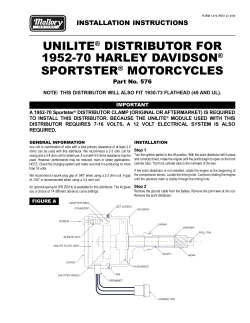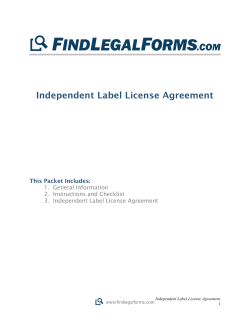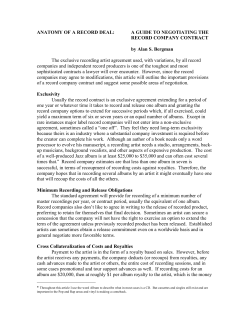
DISTRIBUTION AND P&D AGREEMENTS
DISTRIBUTION AND P&D AGREEMENTS • What is a Distribution Agreement? • How is a Distribution Agreement different to a Recording or Licensing Agreement? • What is a P&D Agreement? • How long do Distribution and P&D Agreements last for? • What happens if I want to record and release other music? • Does the Distributor have the right to sell my records worldwide? • What is the Distributor’s obligation to actually release the sound recordings? • How does the Distributor get paid? • How much will I get paid? • Will I get paid from the first record sold? • How long will I continue to be paid royalties for? • Are there any other royalties I will be paid? • Are there any other ways royalties can be paid? • When will I be paid? • Will the Distributor pay for tours? • Will the Distributor pay for videos? • Are there any other types of distribution deals? This Fact Sheet has been made possible by the funding received by the Creative People’s Centre from the New Zealand Law Foundation. This Fact Sheet is not legal advice. This information is intended to provide a general outline of the relevant legal issues and further professional advice should be sought before any action is taken in relation to the information contained in this Fact Sheet. This checklist remains at all times the property of the Creative People’s Centre. You may make use of this Fact Sheet only for your own personal information. Under no circumstances may this Fact Sheet or the information in it be copied or distributed to any third party by you without the prior written agreement of the Creative People’s Centre. What is a Distribution Agreement? A Distribution Agreement is a legally binding agreement entered into between an artist (either a band or a solo performer) and on the other side either a record label or a company that specialises in the distribution of music (both collectively referred to as a ‘Distributor’ in this Fact Sheet). Under a Distribution Agreement an artist provides a Distributor with finished sound recordings (be it an album, EP or single) ready for sale. It is then the Distributor’s job to distribute the sound recordings to retail outlets and collect from these retail outlets any money due to the artist from the sale of the sound recordings. How is a Distribution Agreement different to a Recording or Licensing Agreement? In comparison to Recording Agreements and Licensing Agreements, a Distribution Agreement is often very similar to a Licensing Agreement. For more information on Licensing Agreements please refer to our Fact Sheet on ‘Recording and Licensing Agreements’. There is however one very important difference in that a Distributor does not generally do any marketing or promotion of the sound recordings it is distributing unless it is specially agreed otherwise with the artist. A Distributor’s job is just to get the finished sound recordings into stores and handle the administration of liaising with the stores, keeping track of the sound recordings supplied (or returned in the case of unsold or defective sound recordings) and making sure all money due to the artist arising from such sales is promptly collected. What is a P&D Agreement? A P&D Agreement is exactly the same as a Distribution Agreement with the exception that under a P&D Agreement the Distributor is also responsible for manufacturing the sound recordings. ‘P&D’ in fact stands for production and distribution. Although a standard P&D Agreement does not automatically include any promotion or marketing elements, there is a variation to the P&D Agreement commonly known as the ‘P&D Plus’, under which marketing and promotion services will be provided by a Distributor. How long do Distribution and P&D Agreements last for? The term of a Distribution Agreement or a P&D Agreement is usually based on how many completed albums, ready for release, the artist and the Distributor agree the artist must deliver to the Distributor. The actual number of albums will depend on the deal that is agreed between the artist and the Distributor. However, these days in New Zealand it is unusual to see more than two or three albums being required and quite often a Distribution Agreement or a P&D Agreement will be limited to two. Under a Distribution Agreement or a P&D Agreement a Distributor will also usually have a right to end the term of the Agreement early if they don’t wish to work with the artist on any future albums provided for under the Distribution Agreement or the P&D Agreement. An artist will never have these rights of early termination under a Distribution Agreement or a P&D Agreement. Under a Distribution Agreement or a P&D Agreement a Distributor will usually also have a period of exclusivity following the delivery to it of an album during which it has the sole right to sell the album. This period of exclusivity can be anywhere from one to ten years depending on the deal. What happens if I want to record and release other music? This will really depend on the wording of the particular Distribution Agreement or P&D Agreement. Depending on how the sound recordings that the artist is required to deliver to the Distributor are defined, it may well be possible that sound recordings made by the artist with side projects or other bands or musicians fall outside of the rights that have been granted to the Distributor. However, the specific wording of the particular Distribution Agreement or P&D Agreement should be carefully checked. For instance, it may well be the case that although the Distribution Agreement or P&D Agreement only requires the artist to deliver say its next two albums to the Distributor, the artist is in fact prevented from commercially releasing any sound recordings during the term of the Distribution Agreement or a P&D Agreement other than through the Distributor, unless the Distributor gives its permission otherwise. Following the end of the term of the Distribution Agreement or a P&D Agreement the artist will be free to release sound recordings through whoever they wish but as noted above the Distributor will retain the exclusive rights to sell the sound recordings licensed to the Distributor under the Distribution Agreement or a P&D Agreement for a further certain period of time. After the end of this further period of time the artist will be free to sell the previously licensed sound recordings themselves or even enter into a new Distribution Agreement or a P&D Agreement with a different Distributor. Does the Distributor have the right to sell my records worldwide? A Distribution Agreement or a P&D Agreement usually define specific countries (often referred to as ‘territories’) in which the Distributor can sell the sound recordings licensed under the Distribution Agreement or the P&D Agreement. Careful consideration should be given to what territories a Distributor will have the right to sell any licensed sound recordings in, in terms of whether the Distributor actually has the practical ability to do this in an effective way. Both Distribution Agreements and P&D Agreements should also have some right for the artist to arrange for someone other than the Distributor to sell the sound recordings in a certain territory if the Distributor becomes unable or unwilling themselves to arrange for the selling of the sound recordings. What is the Distributor’s obligation to actually release the sound recordings? The Distributor should agree to release the sound recordings within the applicable territories within a certain period of time from the delivery to the Distributor of the finished sound recordings. This is often three months but will be conditional on the artist providing the Distributor with all information and materials that the Distributor reasonably needs from the artist. If this release obligation is not met then the artist should have the option to arrange themselves for the release of the sound recordings in the applicable territories in which the sound recordings haven’t been released and in which case the Distributor should also lose the right to distribute sound recordings in those territories in the future. The Distributor should also be obligated to keep the sound recordings on continuous release within the territory during the period of time they have rights in the applicable sound recordings or else the artist should be given the option of arranging for such ongoing release themselves. How does the Distributor get paid? The Distributor will take a percentage (usually somewhere around 20% - 25%) of the income generated from the sale of the sound recordings that they distribute. This is often referred to as the Distribution Fee. How much will I get paid? The artist will receive the remainder of the income generated from the sale of the distributed sound recordings after the deduction of the Distribution Fee. In the case of a P&D Agreement, in addition to deducting the Distribution Fee, the Distributor will also deduct from any money due to the artist the costs incurred by the Distributor in manufacturing the sound recordings for sale. In the case of a P&D Plus Agreement, in addition to the above costs, the Distributor will also deduct any amounts which have been agreed between the artist and the Distributor in respect of promotional and marketing activities in respect of the sound recordings. Rather than being specifically repaid here, these costs can sometimes be covered by the artist and Distributor agreeing for a higher Distribution Fee to be paid to the Distributor. Will I get paid from the first record sold? Generally speaking under a Distribution Agreement or a P&D Agreement an artist will be paid from the first sound recording sold. This will be subject to the artist having to first repay any advances that may have been paid to the artist by the Distributor from the artist’s share of the income generated from the sale of the distributed sound recordings. Also in the case of an applicable P&D Plus Agreement an artist would also have to first repay any amounts which have been agreed between the artist and the Distributor in respect of promotional and marketing activities arranged by the Distributor in respect of the sound recordings. How long will I continue to be paid royalties for? An artist will continue to be paid royalties for as long as the Distributor has the rights to sell the artist’s sound recordings. Are there any other royalties I will be paid? Apart from the sale of sound recordings there are a number of other ways that a Distributor can make money out of the sound recordings it controls. Examples of these other uses include arranging for the sound recordings to be used in films, TV programs, video games or in commercials or even to be sampled in other artist’s songs. Under a Distribution Agreement or a P&D Agreement a Distributor will not always automatically be licensed the rights in the sound recordings to arrange for these other uses of the sound recordings. If the Distributor is not given these rights then the artist will be free to pursue these other opportunities directly themselves. If these types of rights are granted to the Distributor then it should be very clearly specified the income split that is to apply in respect of any income generated from the use of the sound recordings in this way. Frequently the income split for these other types of income will be based on the income split that applies between the artist and the Distributor in respect of the sale of the sound recordings. This is however dependant on the specific deal in question and consequently the Distributor’s share of such additional use income can be higher or lower depending on the deal. Are there any other ways royalties can be paid? Under a Recording Agreement or a Licensing Agreement the way in which royalties are payable to the artist can be worked out in different ways, such as a set percentage of each sound recording sold or a split of the overall profit made from the whole project. However, under a Distribution Agreement or a P&D Agreement, the artist’s share of income is generally only calculated on the basis explained above. For more information on royalties under Recording Agreements and Licensing Agreements please refer to our Fact Sheet on ‘Recording and Licensing Agreements’. When will I be paid? Under Distribution Agreements or P&D Agreements payment of royalties is traditionally made either every month, every three months or every six months depending on the deal reached between the artist and the Distributor. It is also common to have a provision in a Distribution Agreement or a P&D Agreement which allows an artist to audit the accounts of a Distributor to ensure that all royalties due to the artist are being properly accounted for and paid through. Will the Distributor pay for tours? Generally a Distributor will not be prepared to pay specific advances to the artist to put towards the touring costs of the artist. Will the Distributor pay for videos? Generally a Distributor will not be prepared to pay specific advances to the artist to put towards the production costs of any videos the artist makes. However, in most cases the Distributor will want rights to distribute the artist’s finished videos. Are there any other types of distribution deals? With the range of digital music stores that now sell everything from full track downloads, to ringtones and videos, it is also possible to have Distribution Agreements that just relate to distribution in the digital medium. However often Distributors who provide physical distribution services will also want to provide digital distribution services to an artist as well. The same basic principles outlined elsewhere in this Fact Sheet that apply to physical Distribution Agreements also apply to digital Distribution Agreements. However a key issue with digital Distribution Agreements is that a Distributor should only have digital distribution rights in the same territory that it has physical distribution rights. This is because it is increasingly likely that a record label or Distributor in another territory will not be interested in working with an artist in respect of the distribution of their physical sound recordings, if they don’t also have access to an artist’s digital music assets. This also highlights the very serious issue of initially only entering into a digital Distribution Agreement in your home territory. It can severely restrict your ability to later get a physical Distribution Agreement with another party. Read and understand the provisions of any digital Distribution Agreement VERY carefully.
© Copyright 2025













